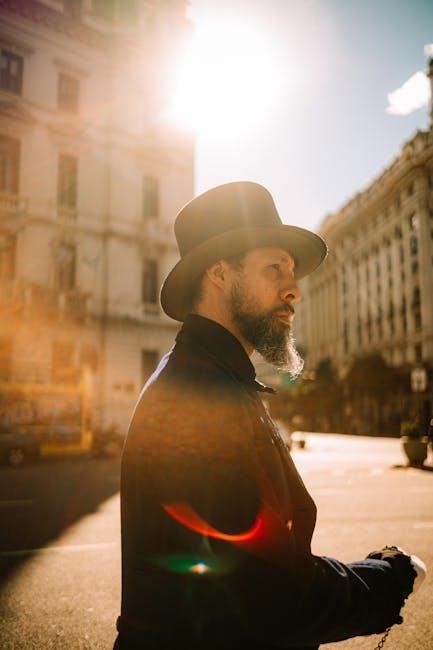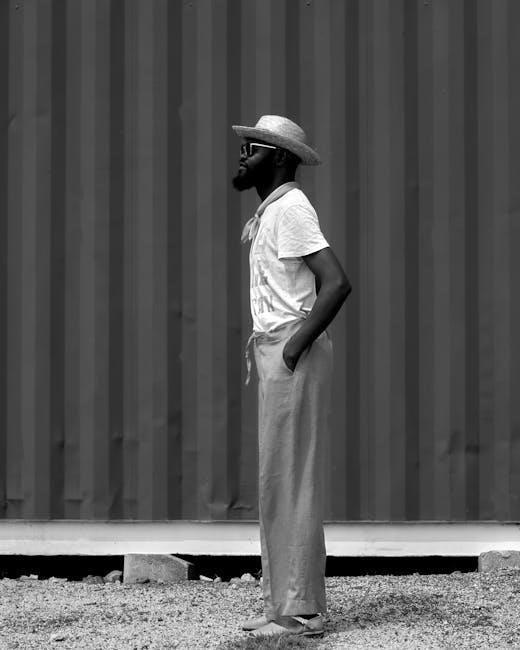Men’s Hat Size Guide
A comprehensive guide to understanding men’s hat sizes‚ ensuring proper fit‚ and exploring various styles to suit different head shapes and personal preferences accurately․
Understanding Hat Sizing Systems
Men’s hat sizing systems vary globally‚ with the US‚ UK‚ and European systems differing slightly․ In the US‚ hats are measured in inches‚ typically ranging from 6 ¾ to 8‚ while the UK uses a similar scale but often starts at 6 ½․ European sizes are numeric‚ ranging from 52 to 62‚ representing the head circumference in centimeters․ Understanding these systems is crucial for accurate sizing‚ as conversions between systems are not always direct․ Materials and styles also influence fit‚ making it essential to consult size charts for specific brands and designs․
- US sizes are based on head circumference in inches․
- UK sizes align closely with US measurements but may vary slightly․
- European sizes use a numeric system based on centimeters․
- Always refer to brand-specific charts for accurate sizing․
How Hat Sizes Are Measured
Hat sizes are determined by measuring the circumference of the head just above the eyebrows and ears․ Using a flexible tape measure‚ wrap it around the widest part of the head to ensure accuracy․ The measurement is then converted into a hat size using a standard chart․ In the US‚ sizes range from 6 ¾ to 8‚ while European sizes are based on centimeters․ Proper alignment and a snug but not tight fit are key for precise sizing․ Always consider the style and brand‚ as some may vary slightly․
- Measure above the eyebrows and ears for accuracy․
- Use a flexible tape measure for the best fit․
- Consult a size chart to convert circumference to hat size․
- Account for style and brand-specific variations․
Importance of Proper Fit in Men’s Hats
A proper-fitting hat ensures comfort‚ style‚ and functionality․ A hat that is too tight can cause discomfort or even headaches‚ while one that is too loose may not stay in place․ The right fit enhances the overall appearance‚ making the hat look intentional and polished․ Proper fit also impacts the hat’s ability to serve its purpose‚ whether it’s for sun protection‚ warmth‚ or fashion․ Ensuring a good fit is essential for maximizing both comfort and style․
- Prevents discomfort or irritation from tightness or looseness․
- Enhances the hat’s aesthetic appeal and intended style․
- Ensures the hat stays securely in place during activities․
- Maximizes the hat’s functional benefits‚ like sun protection or warmth․

How to Measure Your Head for Hat Size
Use a soft‚ flexible tape measure around the widest part of your head‚ just above the eyebrows and ears‚ ensuring a snug but comfortable fit․
Materials Needed for Measuring
To measure your head accurately‚ you will need a soft‚ flexible seamstress tape measure․ If unavailable‚ a string and a ruler can be used as alternatives․ Place the tape measure or string around the widest part of your head‚ typically just above the eyebrows and ears‚ ensuring it is level and not too tight or loose․ This will provide the necessary measurements to determine your hat size effectively․ Always ensure the measuring tool is comfortable and properly aligned for accurate results․
Step-by-Step Measuring Process
To measure your head for hat size‚ start by locating the widest part of your head‚ typically just above the eyebrows and ears․ Wrap a soft tape measure or string around this area‚ ensuring it is level and not tilted․ Hold the tape measure snug but not too tight‚ with the ends meeting at the back of your head․ Read the measurement in inches‚ taking note of the exact number to determine your hat size accurately․ If using a string‚ mark the point where it overlaps‚ then measure the length with a ruler․ Repeat the process to ensure consistency and accuracy․
Tips for Accurate Measurement
For precise measurements‚ use a flexible tape measure or string‚ ensuring it sits level and snug around the widest part of your head․ Avoid slouching or tilting your head‚ as this can distort the measurement․ Take multiple measurements to confirm consistency‚ especially if your head shape varies slightly․ Consider hair thickness and style‚ as these can affect fit; If measuring for a specific hat style‚ account for how tightly or loosely you prefer your hats to fit․ Accuracy ensures the best comfort and appearance in your chosen hat․

Converting Head Measurements to Hat Sizes
Convert head circumference to hat size by matching measurements to standard size charts‚ ensuring accuracy for proper fit and comfort in men’s hats․
Standard Hat Size Chart for Men
A standard hat size chart for men typically ranges from 6 ½ to 8‚ with sizes increasing in ⅛-inch increments․ Head circumference measurements are matched to corresponding hat sizes‚ ensuring a precise fit․ For example‚ a 7 ⅛ size corresponds to a 22 ½-inch circumference․ Regional variations exist‚ with US‚ UK‚ and European sizes differing slightly․ Always refer to the chart for accurate conversions‚ as proper sizing ensures comfort and style․ Measure around the widest part of the head for the best results․
Understanding Hat Size Conversion
Understanding hat size conversion is essential for ensuring a proper fit․ US‚ UK‚ and European sizes differ slightly‚ with US sizes based on inches and UK/European sizes combining inches and centimeters․ For example‚ a US size 7 ⅛ equals a UK size 7 and a European size 56 cm․ Accurate conversion is crucial for international purchases․ Use a size chart to match your head measurement to the correct size in any region․ This ensures comfort and style‚ avoiding the need for adjustments or returns due to sizing mismatches․
How Hat Styles Affect Size
Different hat styles can significantly impact how sizes fit․ For instance‚ fedoras and Panama hats typically fit snugly around the crown‚ while beanies and slouch hats offer more flexibility․ Baseball caps and snapbacks often include adjustable straps for a customizable fit․ The shape and design of the hat‚ such as brim width or crown height‚ can also influence how it sits on the head․ Measuring for specific styles ensures the best fit‚ as some hats may require slightly different sizing due to their unique construction or stretch․

Common Hat Styles and Their Fits
Explore popular men’s hat styles‚ including fedoras‚ panamas‚ beanies‚ and baseball caps‚ each offering unique fits to suit various head shapes and personal fashion preferences․
Popular Men’s Hat Styles
From classic fedoras to versatile beanies‚ men’s hat styles vary widely to suit different preferences and occasions․ Fedoras and panama hats offer a sophisticated look‚ while baseball caps and trucker hats provide casual‚ sporty appeal․ Beanies and knit caps are perfect for colder weather‚ and flat caps add a touch of elegance․ Each style caters to unique head shapes and fashion tastes‚ ensuring there’s a hat to complement every wardrobe and personal style․
How Different Styles Impact Fit
Different hat styles significantly influence fit due to variations in design and structure․ Fedoras and panama hats often feature wider brims and indented crowns‚ which may require adjustments for proper fit․ Baseball caps with adjustable straps offer versatility‚ while beanies and knit caps provide a snug‚ close fit․ Flat caps and newsboy caps have rounded shapes that may sit lower on the head‚ affecting sizing․ Understanding these style-specific traits ensures a more accurate fit when choosing the right hat for your head shape and personal style․
Choosing the Right Style for Your Head Shape
Selecting the right hat style for your head shape ensures both comfort and a flattering look․ For oval-shaped heads‚ most styles work well‚ but fedoras and panama hats are particularly complementary․ Round faces benefit from angular styles like beanies or snapbacks to elongate the silhouette․ Square-shaped heads can soften their features with curved styles such as fedoras or ivy caps․ Understanding your head shape and matching it to the right style ensures a balanced and stylish fit․

Common Hat Fit Issues and Solutions
Common hat fit issues include hats that are too tight or too loose․ Solutions include adjusting the fit‚ using hat stretches‚ or trying different sizes for comfort․
Signs Your Hat Is Too Tight or Too Loose
A hat that is too tight may cause discomfort‚ leave visible indentations on your forehead‚ or restrict blood flow․ If it’s too loose‚ it may slide down or require frequent adjustments․ Look for red marks or a pressing sensation if it’s too tight‚ while a loose hat may gap or sit unevenly․ Proper fit should feel snug but comfortable‚ staying in place without effort․ Pay attention to these signs to ensure your hat is neither overly restrictive nor ill-fitting․
How to Adjust or Modify Your Hat for Better Fit
To improve your hat’s fit‚ try gently stretching it using heat from a hairdryer or steam for tight spots․ For loose-fitting hats‚ consider adding padding or inserts inside the crown․ Adjustable straps or hat bands can also provide a snugger fit․ Using a hat stretcher is another effective method to maintain shape and size․ Experiment with these techniques to achieve optimal comfort and ensure your hat stays securely in place without discomfort or movement․
When to Consider a Different Size or Style
If your hat consistently feels too tight‚ causing discomfort‚ or too loose‚ sliding off easily‚ it may be time to consider a different size․ Additionally‚ if the style doesn’t complement your head shape or face structure‚ explore alternative options․ Hats that obstruct vision or sit awkwardly indicate a poor fit․ Refer to size charts and try different styles or brands to find the best match for comfort and aesthetics․ Proper fit ensures both functionality and confidence in your appearance․

Men’s Hat Size Comparison Chart
A detailed comparison of US‚ UK‚ and European hat sizes‚ providing standard measurements to help determine the perfect fit across different regions and styles effectively․
US vs․ UK vs․ European Hat Sizes
Understanding the differences in hat sizing systems across regions is crucial for accurate fit․ US hat sizes are measured in inches‚ typically ranging from 6 ¾ to 8‚ while UK sizes follow a similar pattern but may vary slightly due to regional standards․ European sizes are often based on centimeter measurements‚ offering a different scale altogether․ Knowing these distinctions helps avoid size mismatches‚ especially when purchasing internationally or online․ Always refer to the specific size chart for the brand or region to ensure the best fit․
How to Use the Chart for Accurate Sizing

To ensure a perfect fit‚ measure your head circumference accurately using a flexible tape measure․ Align the measurement with the corresponding size on the chart‚ considering regional differences between US‚ UK‚ and European sizing․ Double-check the fit by comparing your size across brands‚ as styles may vary slightly․ Use the chart to convert measurements to hat sizes and verify the fit by ensuring the hat sits comfortably‚ neither too tight nor too loose․ This approach guarantees a precise and comfortable fit every time․
Factors That Influence Size Differences
Regional sizing standards‚ such as US‚ UK‚ and European measurements‚ often differ slightly due to varying measurement methods․ Hat styles like fedoras or beanies may fit differently based on design and material․ Additionally‚ the stretch and thickness of fabrics can affect how a hat conforms to your head․ Manufacturing tolerances and brand-specific sizing standards also play a role in size variations․ These factors highlight the importance of checking size charts and trying hats on when possible to ensure the best fit․

Factors That Influence Hat Size
Head shape‚ seasonal changes‚ and material stretch significantly impact hat sizing․ Proper fit ensures comfort and style‚ making accurate measurements essential for the right size․
Head Shape and Hat Fit
Head shape significantly influences hat fit‚ as different shapes require specific styles for optimal comfort and aesthetics․ Oval heads suit most styles due to their balanced proportions‚ while round heads benefit from angular or elongated designs to elongate the face․ Square or rectangular head shapes look best with softer‚ curved styles to balance sharp features․ Understanding your head shape helps in selecting hats that flatter your proportions‚ ensuring both comfort and style․ Proper fit is key to avoiding discomfort and ensuring the hat stays securely in place․
Seasonal Changes and Hat Sizing
Seasonal changes can affect hat sizing due to variations in head measurements and hat materials․ In colder months‚ thicker fabrics and layers like hats with earflaps may require adjusting for a snug fit․ Summer hats‚ often made of lighter materials‚ may fit differently due to less bulk․ Additionally‚ sweat and humidity can cause hats to stretch slightly‚ while colder weather might make hats feel tighter․ Measuring your head in different seasons ensures the best fit‚ as minor fluctuations in size can occur with temperature and humidity changes․
Material and Stretch of the Hat
The material and stretch of a hat significantly impact its sizing and fit․ Hats made from natural fibers like cotton or wool tend to hold their shape‚ while synthetic materials may stretch more․ Knit hats‚ such as beanies‚ offer more flexibility due to their elastic properties․ The stretchiness of the material ensures a comfortable fit‚ but it can also affect how the hat sits on your head․ Measuring your head and testing the fit of a hat in person can help determine if the material will provide the right level of comfort and sizing accuracy․

How Top Hat Brands Size Their Hats
Premium hat brands use precise sizing charts‚ often based on head circumference measurements․ They may vary slightly between brands due to material stretch and design differences‚ ensuring a tailored fit for comfort and style․
Popular Brands and Their Sizing
Top hat brands like Stetson‚ Brixton‚ and New Era use standardized sizing charts based on head circumference measurements․ These brands often provide numerical sizing‚ ranging from 6 ¾ to 8‚ ensuring a precise fit․ Some brands‚ such as Goorin Bros‚ offer additional small‚ medium‚ and large options for versatility․ Factors like material stretch and style variations can influence sizing slightly across brands‚ making it essential to refer to individual brand charts for accurate measurements and a comfortable‚ stylish fit․
Differences in Sizing Across Brands
Hat sizing can vary significantly between brands due to differences in fit‚ material‚ and design․ While most brands follow standard head circumference measurements‚ some may cater to specific fits‚ such as slim or relaxed profiles․ For example‚ a size 7 ⅝ in one brand may feel slightly tighter or looser in another․ Additionally‚ materials like wool or cotton can affect stretch and sizing consistency․ Always refer to individual brand sizing charts for accurate measurements‚ as there is no universal standard across all hat manufacturers․
Tips for Buying Hats Online
When buying hats online‚ always refer to the brand’s specific sizing chart‚ as sizes can vary․ Read customer reviews to gauge fit accuracy and comfort․ Check the return policy in case the hat doesn’t fit perfectly․ Ensure your head measurement is precise by using a flexible tape measure․ Consider the material’s stretch and seasonality—wool hats for winter‚ cotton for summer․ If unsure‚ opt for a classic style that suits your face shape and head size․ Prioritize brands known for consistent sizing and quality․

Knitting or Sewing Your Own Hat
Creating a custom hat allows for a perfect fit․ Measure your head accurately‚ choose a pattern that suits your style‚ and select yarn that matches your needs․
How to Measure for a Homemade Hat
To create a custom-fit hat‚ start by measuring your head accurately․ Use a flexible seamstress tape measure‚ wrapping it around the widest part of your head‚ just above your eyebrows and ears․ Ensure the tape is level and not too tight or loose․ Record the measurement in inches‚ then convert it to your hat size using a standard chart․ Consider the stretch of the yarn or fabric to ensure comfort․ Proper measurement guarantees a well-fitting‚ homemade hat tailored to your unique head shape and style preferences․
Choosing the Right Pattern and Yarn
Selecting the appropriate pattern and yarn is crucial for a homemade hat․ Consider the hat style‚ season‚ and personal preference when choosing a pattern․ For winter‚ opt for thicker yarns like wool‚ while breathable cotton or linen is ideal for summer․ Ensure the yarn weight matches the pattern’s requirements‚ whether bulky or worsted; Choose yarn colors and textures that complement your wardrobe and desired aesthetic․ Check the pattern’s skill level to ensure it suits your experience․ Finally‚ verify that you have the necessary tools‚ like knitting needles or crochet hooks‚ before starting your project․
Adjusting the Fit During the Making Process
While crafting your hat‚ ensure a perfect fit by trying it on periodically․ If the hat feels too tight‚ consider adding a few more rows or increasing the stitch count․ For a looser fit‚ reduce the number of stitches or adjust the pattern․ Pay attention to the material’s stretch—wool and cotton blends may offer more flexibility than synthetic fibers․ If the hat is nearly complete but slightly snug‚ blocking it with water or steam can help relax the fibers․ For a more secure fit‚ incorporate an elastic band or adjustable strap during the final stages of assembly․
Final Tips for Finding the Perfect Hat
Always measure your head accurately using a flexible tape measure for the best fit․ Consider your face shape and personal style when selecting a hat․ Opt for breathable materials like cotton or wool for comfort․ Try hats on if possible‚ and don’t hesitate to ask for sizing advice․ Pay attention to the hat’s crown height and brim width to ensure it complements your features․ Finally‚ personalize your hat with accessories or slight modifications to make it uniquely yours․ Confidence and comfort are key to pulling off any hat style!
Importance of Proper Fit for Comfort and Style
A well-fitting hat is essential for both comfort and style․ A properly sized hat ensures all-day wearability without causing discomfort or headaches․ It also enhances your appearance‚ as a hat that fits correctly frames your face and complements your outfit․ An ill-fitting hat‚ whether too tight or too loose‚ can be unflattering and distracting․ Prioritizing proper fit boosts confidence and ensures the hat looks its best․ Remember‚ a hat is more than an accessory—it’s a statement‚ so make sure it’s a comfortable and stylish one․
Encouragement to Explore Different Styles
Exploring various hat styles can elevate your wardrobe and reveal new aspects of your personality․ Whether you prefer classic fedoras‚ casual beanies‚ or elegant panamas‚ each style offers a unique way to express yourself․ Don’t be afraid to step out of your comfort zone—trying new looks can refresh your image and uncover what truly suits you best․ Consider your head shape‚ face structure‚ and personal style when experimenting with designs․ The right hat can transform an outfit and boost confidence‚ so embrace the adventure and discover the perfect fit for every occasion․